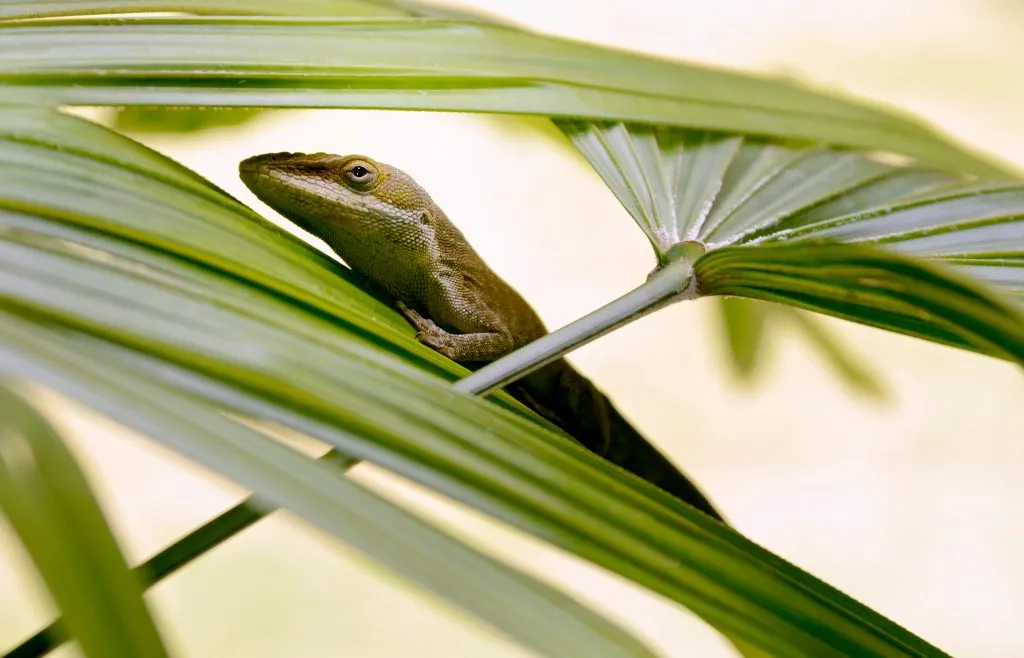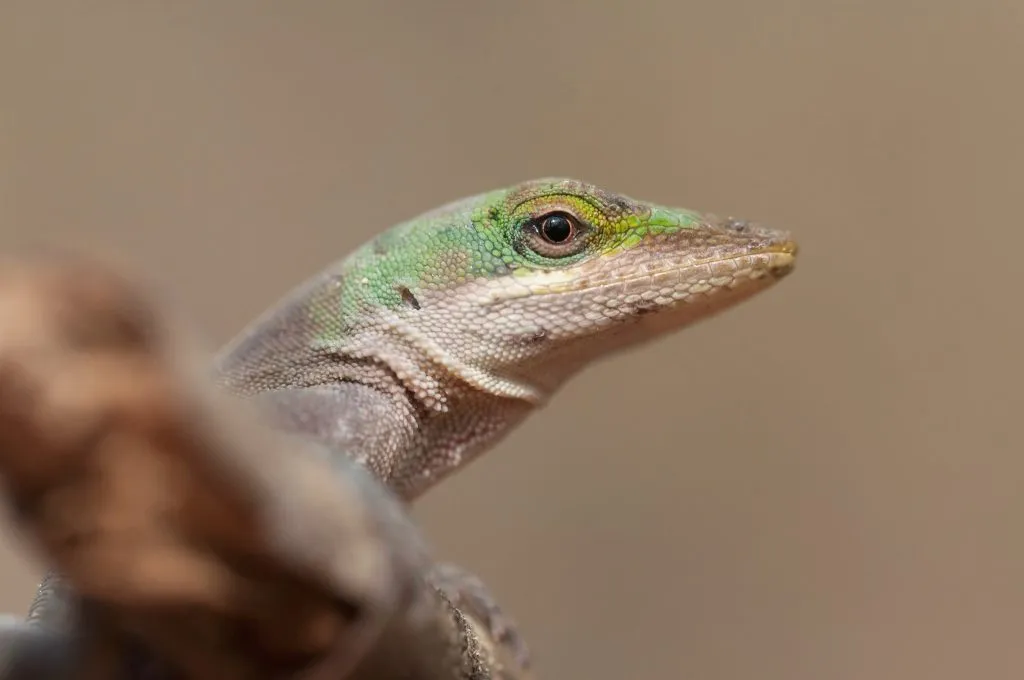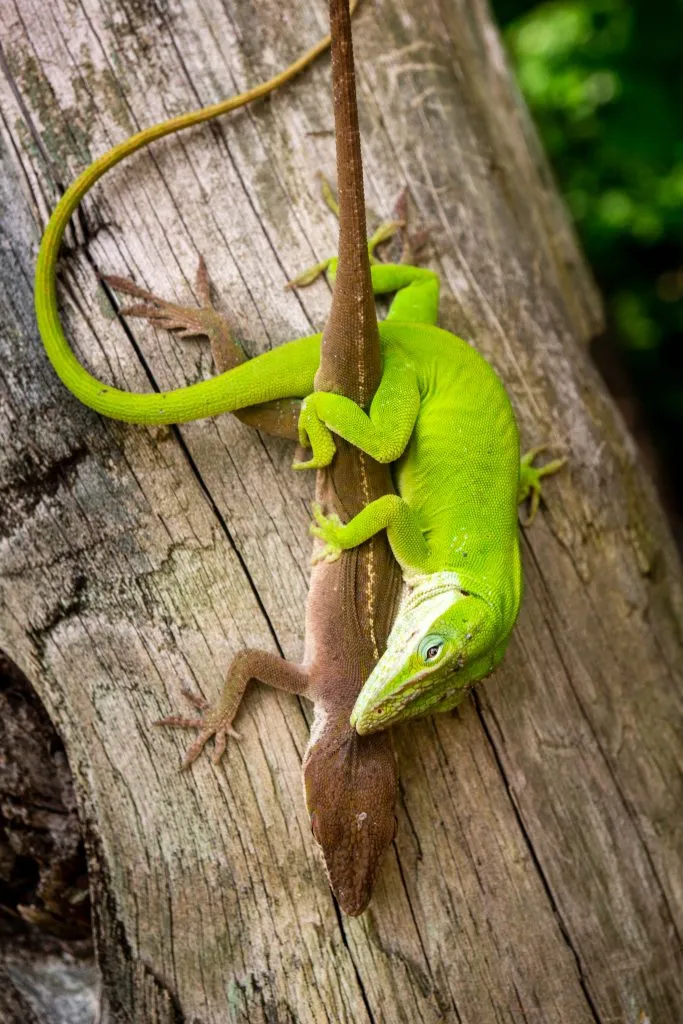
Oh no, your once vibrant green anole has just turned a dull brown! Yes, green anoles can change color but only between green and brown. The reason why your lizard switches hues depends on many factors.
Green anoles turn brown due to environmental, psychosocial, and physiological causes. They typically change color when they are cold, stressed, or ill. Moreover, color changes more commonly reflect their mood than an intention to camouflage.
Throughout the day, expect your green anole to change brown and then back to green. It may not be typical, though, for it to remain brown for several days. Read on to learn 9 reasons for their color change and know what your lizard’s body language is trying to tell you.
Table of Contents
Environmental Factors That Turn Green Anoles Brown

1. Unnatural Habitat
Does your enclosure closely mimic the anole’s natural habitat?
Anoles feel stressed if their environment doesn’t feel natural. Stress and even boredom caused by an artificial environment can cause them to turn brown and remain that way.
As anoles are shy and active, they love climbing branches and hiding between leaves. Happy anoles find lots of covers, privacy, and high perches.
A terrarium with plenty of natural greenery, real branches, and a suitable substrate would help your green anole thrive.
It is also vital to note that green anoles are arboreal, so their enclosure needs to be tall and wide.
2. Temperature and Lighting
Green anoles thrive in humid and warm environments. If it feels too cold, it will turn brown.
To avoid this, maintain the temperature in their basking area between 85℉ and 90℉. Also, create a separate cooler area of 70–75 ºF where the lizard can escape when it becomes too warm.
Use a full-spectrum UVA and UVB light. Turn on this light 10–12 hours daily, allowing the anole to metabolize and synthesize vitamin D3.
Wanna know everything about caring for green anoles? Have a look at our green anole care guide here!
Psychosocial Factors Why Green Anoles Turn Brown

3. Territorial Space
Green anole males are highly territorial. They can turn brown when stressed or angered at encountering another male in their enclosure.
After a fight, the winner walks away, back to its confident green color. The loser remains a sad brown.
A tall 10-gallon
Tip: If you would like to know what
tank size you need for a group of green anoles and what the best tank mates for green anoles are, read our article here!
4. Security
A happy, secure green anole is bright green most of the time. But once it perceives a predatory move, it can turn brown in seconds!
Your lizard could suddenly turn brown when it sees your cat peering at it. It has spied a potential threat and wears emotional stress on its skin!
Fun fact: Although dubbed the “American chameleon,” green anoles do not necessarily change color to camouflage themselves. For this reason, they are not true chameleons.
5. Gender Behavior
A study has found that female green anoles are more likely to turn brown when encountering males.
It states, “As for females who generally display darker brown colors, it has been proposed that darker colors may function as a submissive social status to regulate interactions with males and may even signal reception to male courtship.”
Wondering if your green anole might be pregnant (gravid)? Find our by reading our guide on that!
Physiological Reasons Why Green Anoles Turn Brown

6. Hormones and Mood
Studies show that following a fight, the testosterone levels of loser males fall as much as 60%. While these losers feel defeated and submissive, they remain brown.
Meanwhile, the victors regain their vivid green color as their hormones return to normal.
7. Dehydration
New owners of green anoles must recognize signs of dehydration. Turning brown is just one among a host of symptoms. This dry condition can turn fatal fast.
It is crucial to keep the enclosure moist by misting once or twice daily and maintaining humidity between 60% – 70%.
Green anoles mostly drink water from droplets on plants’ leaves and the
8. Diseases
The presence of parasites in green anoles can cause stress and lead to a change in their coloration.
Flatworms, for example, can cause weight loss, lethargy, and digestive issues. These problems induce skin color changes.
Respiratory illnesses and skin issues can also cause the green anole to brown.
It is critical to have a veterinarian check your lizard when it continues in its brown-hued state. Underlying health issues may need immediate attention.
9. Shedding
During shedding, green anoles’ skin may temporarily turn brown. Old skin peels off, revealing newer, brighter skin underneath.
Under the outermost layer of skin, known as the dermis, the brighter shade of green becomes more evident as the old skin sheds.
Shedding allows green anoles to eliminate old skin cells and grow new ones, maintaining their health and integrity.
In conclusion, there are a variety of causes for a green anole’s coloration to change. Some of these factors depend on temperature, mood, well-being, and interactions with other anoles.
To keep your green anoles healthy and content, it’s crucial to keep a close eye on their habitat and health.
- Enchi Ball Python: A Unique and Stunning Morph of Python regius - March 27, 2025
- Emerald Tree Monitor: The Enigmatic Green Guardian of the Rainforest - March 26, 2025
- The Egyptian Cobra (Naja haje): A Fascinating Serpent - March 25, 2025
